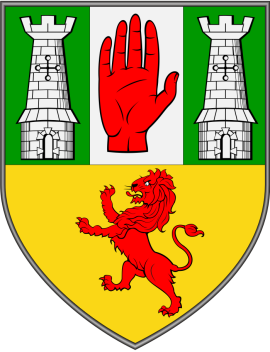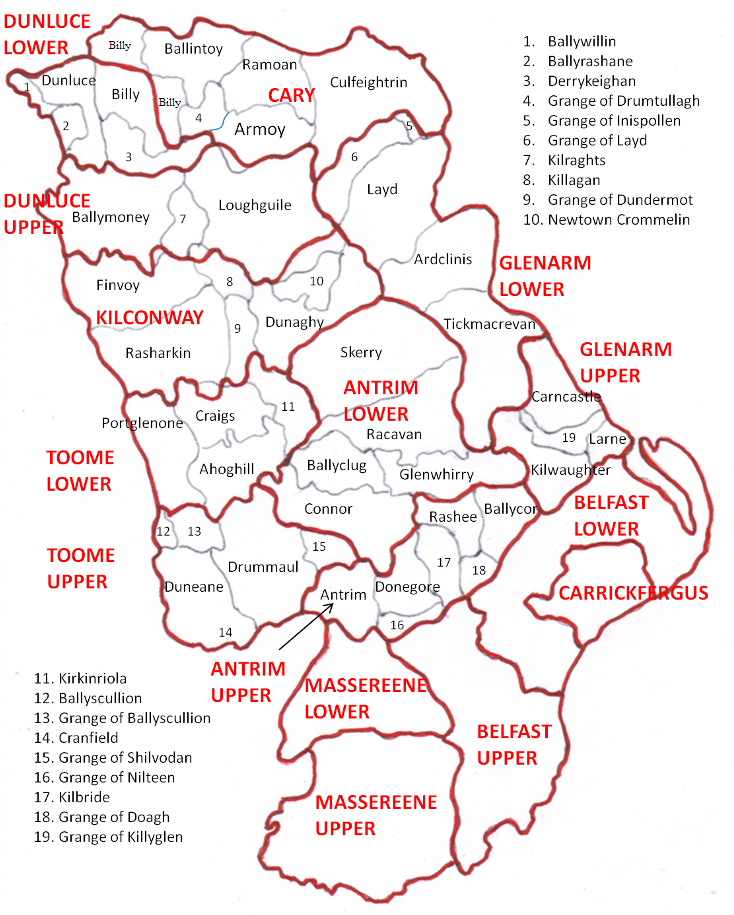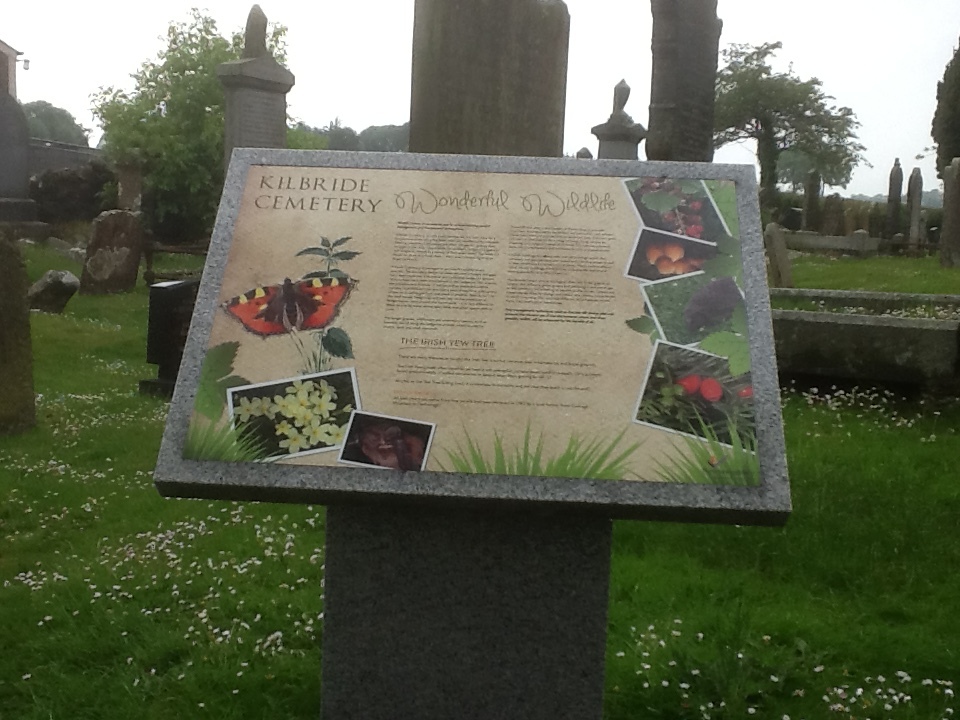The Antrim Coat of Arms "Through Trials to Triumph"
County Antrim: Baronies (red) and Parishes (black)
Ireland - old map 1808. The four historic regions, Ulster (blue), Leinster, Connaught, Munster
Northern Ireland - Port Donaghadee Port Patrick -Scotland
How Scottish Immigrants may have travelled - it was only 20 miles across the Irish sea by boat from Port Patrick, Scotland to Port Donaghadee, County Down, Northern Ireland. Antrim was the county North of County Down (Belfast also being in County Antrim)
Port Patrick - Scotland, Donaghadee's sister Port. The presence of cutters suggests this view predates 1825
Donaghadee Harbour - County Down, Northern Ireland. After 1849 large steamers were rarely seen and the port's glory days were over.
Donaghadee Famous Limestone Lighthouse - on the night of 11th January 1836, a fixed light shone at the end of the south pier for the first time. It has been regularly painted white for about a century, the first in Ireland to be electrified.
First Ballyeaston Presbyterian Church, Ballyeaston, C0unty Antrim (taken 2015) where GGG GF Thomas Law married Margaret Knox in 1842. The first meeting house was built in 1676, another building replaced this which remained until 1834. The present day church was built on the same site which has remained to this day.
View from First Ballyeaston Presbyterian Church overlooking the Six Mile Water
Reverend William James Raphael - Pastor of the First Ballyeaston Presbyterian Church for 44 years, 1821 - 1865. He was much loved by his flock, highly respected and likely to have performed the marriage between Thomas Law and Margaret Knox in 1842.
First Ballyeaston Presbyterian Church Marriage Entry - 11 February 1842 - Thomas Law Glenwhirry, Margaret Knox, Kilbride (parishes in County Antrim)
Glenwherry (Glenwhirry) Presbyterian Church is very near the principle road through the Parish of Glenwherry, the A36 from Ballymena to Larne on the east coast. GGG Grandfather Thomas Law came from Glenwherry but when he married Margaret Knox in 1842, there was only a Meeting House for worship, the above church had not been constructed and they married at First Ballyeaston.
Kilbride Cemetry, County Antrim. John Knox, father of GGG Grandmother Margaret Knox, who died in 1868, is buried in the Kilbride old graveyard.
A typical post - Irish potato famine eviction scene in rural areas in the 1850's. After the worst of the famine had passed, it was common to see families camped out in the ruins of their house. Between 1849-1854, 250,000 - 500,000 mainly rural people, were forced from their homes usually for rent arrears. The fortunate emigrated to America or elsewhere and the less fortunate the 'workhouse'.
PRONI - Public Record Office of Northern Ireland, Belfast, County Antrim.
THE Law sTORY goES 'IrisH'
Introduction
The 1851 Scottish census on 31st March was the first census to record the Law family. The household in Peesweep Row, Dalry, Ayrshire included Thomas Law, my GGG Grandfather, his wife GGG Grandmother, Margaret (maiden name Knox), their four children, John, Ann, Alexander, William, Thomas' mother Susan (maiden name McKrae, a widow) and Thomas' wife's brother Samuel Knox. The census showed all were born in Ireland, apart from William who was only two months old and born in Dalry. This revelation led me to investigate the ancestral trail further in Ireland. It seems likely due to the age of William, that they all may have left Ireland for a new life and work back in Scotland late 1850 or early 1851. The following will try and shed light on this Irish phase in Law family history.
Evidence of Law and Knox family members living in COunty Antrim,northern ireland
Baptism Register, children of John Knox and wife Ann Graham, (Margaret Knox's father and mother) Ballyeaston Presbyterian Church Records: Alexander 8 March 1829, Drummadarra, Samuel 7 March 1831 Rashee Bow, John 18 April 1834 Drummadarra, Mary Ann 3 February 1837 Rashee. All are Parishes in County Antrim near to each other. Margaret Knox, the eldest of the children, born about 1820, is thought to come from Donegore, another neighbouring Parish.
Death Certificate of GGG Grandmother Margaret Knox's father, John Knox wh0 died in 1868, gave his place of death as Kilbride, District of Doagh, evidence for placing his generation and the Knox family in County Antrim.
Death Certificate Susan McCrae, 1860 in Dalry, Ayrshire, Scotland - mother of GGG GF Thomas Law above, indicates she was born in Ireland and a widow at the time of her death. Her husband, also a Thomas Law, was a farmer, her father was Rodie McCrae, a soldier and her mother was Agnes Knox.
Death Certificate of GGG Grandfather Thomas Law who died in 1872 in Kirkintilloch, Scotland gave his parents' names Thomas Law and Susan Graham (she is also known in documents with surname McCrae and with different spellings). Subsequent research has shown this earlier generation were also from County Antrim.
Marriage Certificate GGG Grandfather Thomas Law and Margaret Knox, 11 February 1842, First Ballyeaston Presbyterian Church, Ballyeaston, County Antrim, states Thomas was from Glenwhirry and Margaret from Kilbride, both Parishes in County Antrim.
Children of GGG Grandfather Thomas Law, eldest sons John and Alexander were born in County Antrim, evidence as seen in e.g. 1891 Scottish census. No birth/baptism records have yet been found.
The County Antrim connection gave me a good place to start, I was intrigued to establish:
1. Why they left Scotland and migrated to Northern Ireland
2. How they may have travelled to Northern Ireland
3. Where Law and Knox family members lived in County Antrim - ancestral visits
4. Why they returned to Scotland
Scotland in the late 16th century was an era of economic distress due to harvest failures, outbreaks of plague and by the early 17th century famine was relatively common. Religion changes due to the Dissolution of the Catholic Monasteries by King Henry v111 (1536-41): Ireland, Scotland and England were Roman Catholic but while England and Scotland adopted a new Protestant religion, the Irish remained resolutely Catholic. In Scotland, many rejected the Established Anglican Church and favoured the emerging Protestant Presbyterian faith, which eventually became the Established Church of Scotland.
The History of the Protestant Scots who came to Northern Ireland (Ulster) in the early 17th century allowed me to learn more of the Law Migration to County Antrim.
County Antrim is part of Ulster which is one of the four historic provinces of Ireland - see old map. Ulster consists of six counties, Antrim, Down, Armagh, Londonderry, Fermanagh, Tyrone in Northern Ireland and three in the Republic of Ireland, counties Cavan, Donegal and Monaghan. The strong Presbyterian presence in Antrim and Down is due largely to the many Scottish lowlanders who came to the rural glens and rich farming lands of Northern Ireland during the Plantation of Ulster which began in the early 17th century and continued into the early 18th century.
Ulster was the last province to be brought under the control of the English Crown and after the nine years war and defeat (flight) of the Irish Earls in Ulster, their land was parcelled out to new Scottish and English landowners (undertakers) who colonised (planted) this land with Scottish and English settlers.
The First Plantation of Ulster in counties Antrim, Down and Monaghan, is regarded as a PRIVATE PLANTATION before the official Plantation by James 1 a few years later. James v1 was the King of Scotland and also King of England and Ireland as James 1 (1566-1625), he ruled England and Ireland from 1603 until his death.
The Private Plantations in the early 17th century resulted in large - scale migration of Scottish and English settlers to Antrim and Down. In the south of Antrim due to acquisition of land by wealthy English landowners e.g. Sir Arthur Chichester. Famous Scots, James Hamilton and Hugh Montgomery also acquired large estates (originally Con O'Neill's land) and Scottish settlement was heavier here than in any other part of Ulster. Montgomery landed in Down in 1606 and the Scots made the new settlements flourish, although some were fleeing from debt and scandal.
The Official Plantation of Ulster. Six counties of Ulster were affected by the 'official plantation' but this did not extend to counties Antrim, Down and Monaghan. The Scottish and English who came were non-conformists and settled further west.
Likely Reasons for Law Migration to Ulster. Due to poor living conditions and prospects in Scotland and the opportunity to work on rich farming land not far away, it is likely they may have come in the early 17th century so generations of Scottish Laws could have been in Ulster for over 200 years before their return to Scotland. Evidence: Ordnance Survey Memoirs of Ireland, the Parishes of Antrim x11 state that Glenwhirry, where GGG GF Thomas came from when he married Margaret Knox in 1842, was settled by people of Scotch descent and colonised about 1609 or 1610. Ordnance Survey Memoirs of Ireland, the Parishes of Kilbride x1 state that Kilbride, where GGG GM Margaret Knox came from when she married Thomas Law, was colonised by the Scottish settlers of the 16th or 17th centuries but particularly by those who came over in the years 1610 and 1641. They were almost exclusively Presbyterian.
How Scottish immIgrants travelled to Northern ireland
Port Patrick, on the SW coast of Dumfries and Galloway and south of Ayrshire, Scotland, was only a short sea journey to the Port of Donaghadee, County Down, Northern Ireland. Approximately 20 miles by boat and two hours by sail, this route became known as the 'short sea passage' and remained the preferred route until 1868 when Stranraer to Larne, County Antrim became the favoured passage. In 1606, Donaghadee was the point of entry for most of the Scottish Presbyterian settlers brought in by Hugh Montgomery from Ayrshire. Donaghadee was in its heyday, a small town with a bustling Port and widely known as the Gateway to Ulster. In the 18th century, passengers preferred to travel to and from Donaghadee (rather than to Belfast) as the single-masted sloops and cutters were sleeker than braques and brigs. In the long term, these sea journeys proved hazardous and could not support all vessels.
ANCESTRAL visits to the places law and knox family members lived in county ANtrim
My journey began in Belfast, County Antrim where I visited PRONI, the Public Record Office of Northern Ireland. I concentrated on searching Church Records using the microfilm readers and was fortunate to discover much of the evidence outlined above which gave me Place names such as Ballyeaston, Glenwhirry and Kilbride to explore further.
BALLYEASTON is a Townland in the Parish of Ballycor, barony of Upper Antrim, County Antrim. It was the site of one of four churches in the area founded in the 5th century by Saint Patrick, the others at Rashee, Ballycor and Ballynure. In the early 17th century, the newly arrived Scottish settlers set about clearing the heather and stones, draining marshes and planting hedges. It is described in the Ordnance Survey Memoirs of Ireland, in about 1835, as a place that does not in any way tend to ornament the landscape! It is desolate looking being situated on a bleak mountain. The people are described as very poor, used to hard labour, have a very strong Scottish accent and their diet mainly oatmeal porridge, milk and potatoes. Dancing is their favourite amusement in winter and they like to go to summer fairs where some consume too much whiskey..
First Ballyeaston Presbyterian Church where GGG GF Thomas and Margaret Knox married in 1842. This congregation was first formed as part of Ballyclare (a market town close by) and many capable Presbyterian ministers settled in the Six Mile Water area having fled the persecution from James 1. The Church of Ireland welcomed these non conformists. In 1672 the people of Glenwherry annexed themselves to Ballyclare and between 1676-1681, Ballyeaston was erected into a separate congregation, a primitive Meeting house built in 1676 for worship, the first Minister was Mr William Adair. Another building replaced this which remained until 1834 when, during Reverend Raphael's ministry, (1821-1865), the present day church was built on the same site overlooking the Six Mile Water valley. The Reverend William Raphael was highly regarded in Ballyeaston and by the Presbytery and he is likely to have preformed the marriage service between Thomas Law and Margaret Knox. He was also instrumental in the formation of the Kilbride Presbyterian church in 1848.
Second Ballyeaston Presbyterian Church. A few hundred yards up the road is the second Presbyterian congregation in the same village. This church, originally called Rashee Presbyterian Church, was founded in 1763 as a Seceder congregation (not uncommon in Ulster) and is located at the Five Corners.
GLENWHIRRY (Glenwherry) is a Parish in County Antrim and consists of Upper and Lower Glenwhirry. It is divided into 13 Townlands and situated near the centre of County Antrim, about 16 miles from Belfast, 6 miles west of Larne on the coast and southeast of Ballymena. Bounded on the north by Parishes Racavan and on the south by Ballycor, Rashee and Connor. I found the area to have lush farming land and to be quite steep and hilly in places. It is where GGG GF Thomas lived when he married Margaret Knox in 1842. There was a Meeting House for worship but no Presbyterian church at this time in Glenwhirry. The congregation of First Ballyeaston Presbyterian church came from these surrounding areas until more Presbyterian churches were erected in other local Parishes.
Ordnance Survey Memoirs of Ireland in 1832 state that the Parish is wild, mountainous and in a backward state of cultivation. The Glenwhirry River flows through the valley and the moist and boggy soil is subject to mists, rain and frosts. As the Glen is exposed to the SW and westerly winds which blow 9 months of the year, wheat will not ripen. General crops are potatoes, barley, flax and oats. There is no town, village or public building apart from the Meeting House.
Common Surnames are Graham, Saunderson and Bryan. Margaret Knox's mother was Ann Graham and it is noted that there were 18 persons with the name of James Graham. The people were honest, industrious, frugal and sober. They attended their farms and cattle and some manufactured linen. Farms were 10-40 acres, some larger but were on rough bog or mountain land fit only for grazing. They amused themselves by fishing, hunting and dancing.
KILBRIDE is a Parish in County Antrim, the District of Doagh, Barony of Upper Antrim. It is where GGG GM Margaret Knox lived when she married Thomas Law in 1842, it is where John Knox, her father died in 1868. He is buried in Kilbride old graveyard but I could not locate a head stone.
Ordnance Survey Memoirs of Ireland in 1832 state that it is a long and narrow Parish and extends from the Collin mountains in the north to the Six Mile Water in the south. It is 11.5 miles from Belfast. Kilbride is bounded by Parishes Rashee, Connor, Templepatrick, Donegore and grange of Doagh. The Six Mile Water forms the southern boundary, The Doagh River the eastern boundary, a stream called the Four Mile burn, the western boundary. The Six Mile Water area of the parish is a rich and beautiful valley while other parts are less interesting. The settlement by the Scots in the 16th and 17th centuries also brought their ministers which improved the state of the parish as some bought capital with them. The land is held on leases of lives, renewable forever, £1.5s at fall of a life and £3-7 rent an Irish acre to Landlord the Marquis of Donegall. In 1832, the Presbyterians were members of the congregation mainly at neighbouring Donegore. All houses and cottages were built of stone and lime and the cottages thatched. Each cottage would have a small garden and they lived on potatoes, salt herrings and milk, oatmeal occasionally and little animal food. General crops being potatoes, oats and flax in small quantities. They burnt turf for fuel and enjoyed cock-fighting, books, dancing, singing sacred music and summer fairs.
Return to scotland of the Law family
The Laws had worked the land as labourers and farmers in order to survive but then in 1844 a new form of potato blight (an air carried fungus) was identified in America, 'Phytophthora Infestans' which turned a potato into an incredible mush. In 1845 it spread via France and the Isle of White to Northern Ireland where crops were a disaster. Large families were common then but they only grew meagre food for themselves and their diet relied on potatoes. When crops failed, life for rural communities was intolerable as no food meant no jobs and no homes. It is highly likely this was one of the reasons the Law family returned to Scotland as did do many others. The majority of landlords in Ireland showed no sympathy for people who worked their land and if rent was not payed, they were evicted.
The GREAT FAMINE in Ireland 1845-1852 also known as the Great Hunger or the Irish Potato Famine was a period of mass starvation, disease and emigration in Ireland. Impact:
One million people died of starvation and one million people emigrated to America, Scotland and England during this time which reduced the total population by 20-25%.
Many Irish were not welcomed in the areas where they settled in Britain as they were seen as people who undercut wages. Factory owners employed the Irish sometimes at the expense of the English or Scots.
JOURNEY BACK TO SCOTLAND - the short sea passage Donaghadee in County Down to Port Patrick, Scotland was still being used up until 1868 when the new route Larne to Stranraer tookover.
It is likely the 'Laws and their young family' returned by boat from Donaghadee to start a new life in Dalry, Ayrshire, not far from Port Patrick on the SW coast of Scotland. Their third son, William was born in Dalry and two months old in the March 1851 Scottish census so they must have left Ireland late 1850 0r early in 1851. Thomas found work in the Iron mines of Dalry which were flourishing at the time and they lived in Peesweep Row in basic miners' housing rented from the Mining companies.
A new period in the Law Family History then begins in Scotland from about 1850 until they depart for New Zealand in 1922. They were no strangers to 'moving on', they had done it before and knew the hardships. They were not afraid to start again and look for another way to live and a better life for all. Perhaps they thought this was normal and what you had to do, but what courage and strength of human spirit to take such radical steps in order to survive.
SUMMARY
Research for Law Ancestors in Northern Ireland is ongoing and as further details are uncovered I will update these pages. Both Law and Knox family members have been found in County Antrim but many records are still elusive. To date, I have not been able to find birth or baptism records for GGG GF Thomas Law, his first three children born in Ireland, John, Ann and Alexander or birth, marriage, death records for his father, my GGGG GF Thomas Law.
More Descendents? Other Laws, James and Samuel (common family names) have been found in Landed Estate Rent Ledgers and in Griffiths Land Valuation Records prior to and after GGG GF Thomas Law married Margaret Knox in 1842. A James Law rented Lands of Glenwhirry and in 1804 his yearly rent was £7. 1s. 10d. He rented fields near Lodge Road and a Samuel Law also rented fields 'Lodge Road' in the Donegall Estates between between 1797 -1806. The Donegall Estates in southern Antrim (sometimes referred to as Marquess of Donegall Estate), was land acquired by the Chichester family from Devon, England and Sir Arthur Chichester was Lord Deputy of Ireland from 1604-1614. The land was acquired at the time of the Private Plantations by the Scottish and the English in the early 17th century which could have been the time period Law ancestors travelled to Ireland.
Griffiths Land Evaluation records, 1862 also show a James Law, a possible ancestor, in Glenwhirry Parish, Townland Douglas. He may have remained (renting land) whilst other Laws, probably just labourers, travelled back to Ayrshire Scotland. He was no longer renting by 1866 and may have died.These Scottish settlers, James and Samuel Law were therefore living in the Glenwhirry area of Lower Antrim where known ancestors e.g. GGG GF Thomas, have been found.
New Information found in Valuation Revision Books for Glenwhirry, the oldest Parish land valuation records 1828-40. John Law was identified owning a house and grazing animals in 1835 in the Jockeys Quarter Townland of Lower Antrim. It therefore places him and Thomas, GGG GF, living in the same area around the time Thomas married in 1842. They may well have been related but does show more 'Laws' in the same Glenwhirry area. A John Law was also found in Civil Death Records, an unmarried, 80 year old farmer who died in 1905 in Crosshill townland which adjoins Glenwhirry townland. He could well have been a contemporary of Thomas GGG GF as they were born around the same time (1821 -25). This John Law is mentioned on a Gravestone inscription in the Glenwhirry Presbyterian cemetery, along with his brothers' Francis and William Hugh and their mother Rosey Law. More evidence is required however to show if any of the above 'Laws' were related to those ancestors known to have lived in County Antrim at that time.
After extending Presbyterian and Church of Ireland church record searches over a wider radius including Kirkinriola (Ballymena Civil Parish), close to Glenwhirry, no direct Law ancestors were found. Unfortunately most Presbyterian church registers did not commence until the first half of the nineteenth century which makes finding the earliest Law generations very difficult.
Knox family members who remained in Ireland - Alexander Knox and John Knox have been found in Griffith Land Evaluation records, published 1862, in Kilbride and Rashee parishes and could be the other brothers of Margaret Knox who remained in Antrim whilst Margaret and brother Samuel left for Dalry with her husband Thomas Law and the rest of the family. Margaret's father died in Kilbride in 1868 and Alexander (son) was present at his death, so some family were still there and renting land in the area. Due to recent DNA discoveries, the origins of the surname Knox come from the North-West coast and begin in pre-history Ireland! We may all be far more ancient than we ever believed..
Main Family History Resources Used
See also Resources RootsRoutes website for more information on tracing Northern Irish Ancestors
Record Hunting can be difficult as Civil or State Registration of birth, death, marriage only began in Ireland in 1864. Non catholic marriage registration from 1845. Understanding the records held at PRONI is particularly useful for tracing ancestors prior to these dates.
PRONI
Public Record Office of Northern Ireland - 2 Titanic Boulevard, Belfast BT3 9HQ
UHF
Ulster Historical Foundation - The Corn Exchange, 31 Gordon St, Belfast BT1 2LG
BOOKS
Ordnance Survey Memoirs of Ireland - Parishes of County Antrim, edited by Angelique Day and Patrick McWilliams
Researching Scots -Irish Ancestors - The Essential Genealogical Guide to Early Modern Ulster, 1600 -1800 William J. Roulston
The House on the Hill, History of First Ballyeaston Presbyterian Church - Jim Wilson B.A
Donaghadee an Illustrated History - Harry Allen
Old Irish County Life - Hugh Oram
Acknowledgement other Sources of Information/Photos/Maps
Antrim Coat of Arms, Antrim Parishes and Baronies, Ireland old Map, Ireland101, Google
If you have any comments or questions regarding Northern Ireland Family History Research, please contact me to discuss further.















